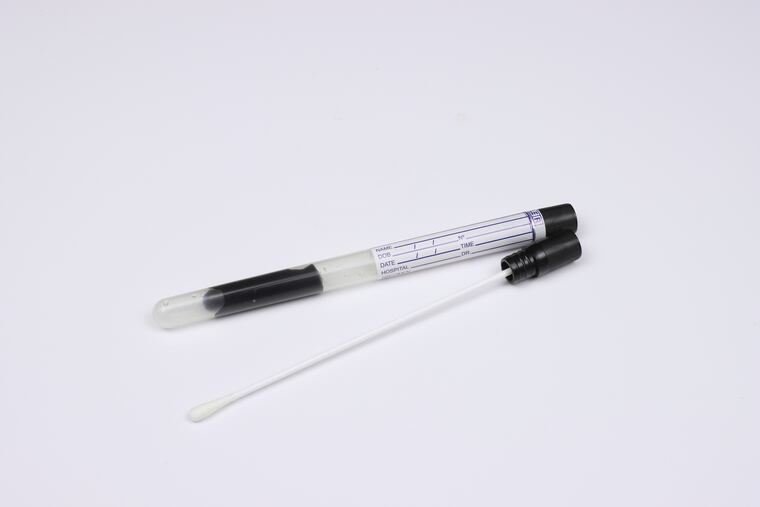Pandemic-weary people are still having risky sex, but STD test kits are in short supply, Philly experts say
“We’re going to have what I think of as a big black hole in a lot of surveillance data for the last few months.”

Public health experts say their fears about pandemic-related testing supply shortages are coming true as tests for sexually transmitted diseases (STDs) decline even as risky sex behavior may be more prevalent.
Last summer, sexual health centers sounded the alarm that the pandemic was affecting their ability to screen patients for STDs. The issue is particularly concerning in Philadelphia, where rates of syphilis, gonorrhea, and chlamydia have for years far exceeded national averages. Many centers had to temporarily suspend their walk-in testing services — some of which serve patients who don’t have health insurance — and saw a drop in the number of people getting tested.
Even through the fall, STD kits at the Children’s Hospital of Philadelphia had to be conserved for patients who qualified under new recommendations released by the Centers of Disease Control and Prevention (CDC) in September, said Sarah Wood, a physician working in the hospital’s division of adolescent medicine. The new guidelines recommend testing asymptomatic women under age 25 and asymptomatic men who have sex with men.
To conserve test kits, physicians at CHOP have stopped testing symptomatic patients or patients whose partners tested positive. They just presume they have an STD and give them antibiotics, something physicians would rather not do given antibiotic overuse and resulting resistance.
“COVID testing led to substantially fewer [STD] tests for us as we had some problems along our supply line,” Wood said. “We don’t know the long term effects of that yet.”
Wood noted that untreated STDs can have long-term repercussions such as impaired fertility.
In North Philadelphia, staff at Bebashi, a full-service HIV/AIDS organization that serves people of color, devised an unconventional solution to the shortage of testing swabs for chlamydia and gonorrhea, said Alvin Kingcade, practice manager at the clinic.
» READ MORE: COVID-19 has interrupted STD screenings in Philadelphia (from June 2020)
“We sent urine cups to the lab we use and they have been able to process them,” he said, because the bacteria also show up in urine and can be detected through DNA amplification techniques. “Because we’ve stayed open this whole time, we actually saw a higher number of patients treated. There was actually an increase between September and November.”
Another factor is staffing. On Jan. 28, the National Coalition of STD Directors released a survey that showed 40% of workers at STD programs have been deployed for COVID-19 efforts largely because of their experience in contact tracing for infectious diseases. This has resulted in a decline of STD screening and treatment — program directors across the country have reported a 28% decrease in chlamydia intervention services, a 23% cut in syphilis intervention services, and an 18% decline in gonorrhea intervention services.
While Center City’s Mazzoni Center hasn’t lost staff to COVID-19 contact tracing efforts, social distancing measures have decreased the number of patients the staff can treat in a day, said Eric Paulukonis, prevention services director. Typically, the center, which focuses on the LGBTQ community, conducts 200 tests a week, he said, but that number has dropped to a maximum of 60 a week during the pandemic. They’ve also had to stop services a few times during the pandemic due to test kit shortages.
“We’ve been providing just a fraction of the screenings we normally do,” Paulukonis said. “We can’t see as many patients so we need to focus on those who are at risk for STIs or HIV. That’s all figured out on the phone, and if a person is at risk for an STI, they come in for in-person testing.”
Paulukonis said he is concerned by the high positivity rate the center has seen for gonorrhea and chlamydia.
“We do know from clients that people are still having sex,” Paulukonis said. “They’re still exhibiting the same behaviors, but there’s a reduced amount of screening happening. When you look at chlamydia, it doesn’t always have the obvious symptoms and could be circulating pretty widely. That’s the scary part.”
Wood, at CHOP, said she is particularly concerned about how testing interruptions will affect data public health experts have been gathering on the rising numbers of STDs. Without that data, it becomes very difficult to know not only case rates, but also where and for what groups STD occurrence is highest.
“We’re going to have what I think of as a big black hole in a lot of surveillance data for the last few months,” Wood said. “We need good data to get funding and the resources we need, and that data has been compromised.”
Wood also emphasized the importance of having conversations with teenagers to make sure they’re aware STDs are increasing. She said half of the infections are happening in teens.
“For everyone, there’s no better time to use condoms,” Wood said. “That is a supply that is still going well.”